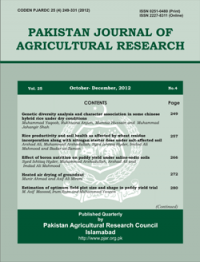PARTIAL RESISTANCE TO STRIPE RUST AND ITS EFFECT ON SUSTAINABILITY OF WHEAT YIELD
Maqsood Qamar*, S. Dilanawaz Ahmad Gardazi**, Riaz-ud-Din*, Muhammad Sohail* and Syed Haider Abbas*
ABSTRACT
Stripe rust (Puccinia striiformis Westend. f. sp. tritici) poses a serious threat to wheat production in cooler areas of Pakistan. The 70% area of wheat in Pakistan is prone to stripe rust disease. It can cause 10-17% yield losses if susceptible cultivars are planted under favorable conditions. Level of partial plant resistance in bread wheat and its impact on sustainable wheat production was studied at the National Agricultural Research Centre, Islamabad under natural conditions in the field. Eleven Pakistani commercial wheat cultivars/advance lines including check (Inqalab 91) were assessed for the level of partial resistance against stripe rust using Area Under the Disease Progress Curve (AUDPC), disease severity (DS) and epidemic growth rate in comparison with wheat cultivar, Inqalab 91. During 2007 cropping season, natural epidemic was developed and relative AUDPC was recorded from 0 to 100% whereas the 2008 cropping season was dry and no stripe rust appeared. Two advanced lines (NR 268 and NR 285) showed the infection type (IT) less than 7 (incompatible reaction) to the mixture of prevailing stripe rust inoculums. Very low level of DS and AUDPC were recorded in the remaining cultivars/lines indicating a high level of partial resistance to stripe rust compared to the susceptible check cultivar, Inqalab 91. Among eight cultivars/lines that showed compatible type of reaction (IT ≥7), one was resistant (relative AUDPC ≤ 20% of Inqalab 91) and six showed very high resistance levels (relative AUDPC ≤5%). Maximum level of resistance (relative AUDPC = 0.1%) was observed in advanced line, NR 271. The wheat cultivars/lines that showed a slow disease development (low DS and AUDPC), could be considered as -1 partially resistant for stripe rust infection. The yield (2178 kg ha ) of susceptible check cultivar Inqalab-91 during 2007 was reduced to 45% as -1 compared to its yield (3945 kg ha ) in epidemic free year (2008). Thus the use of these partially resistant cultivars/lines in hybridization programme or their cultivation can considerably reduce yield losses incurred by stripe rust.
To share on other social networks, click on any share button. What are these?






